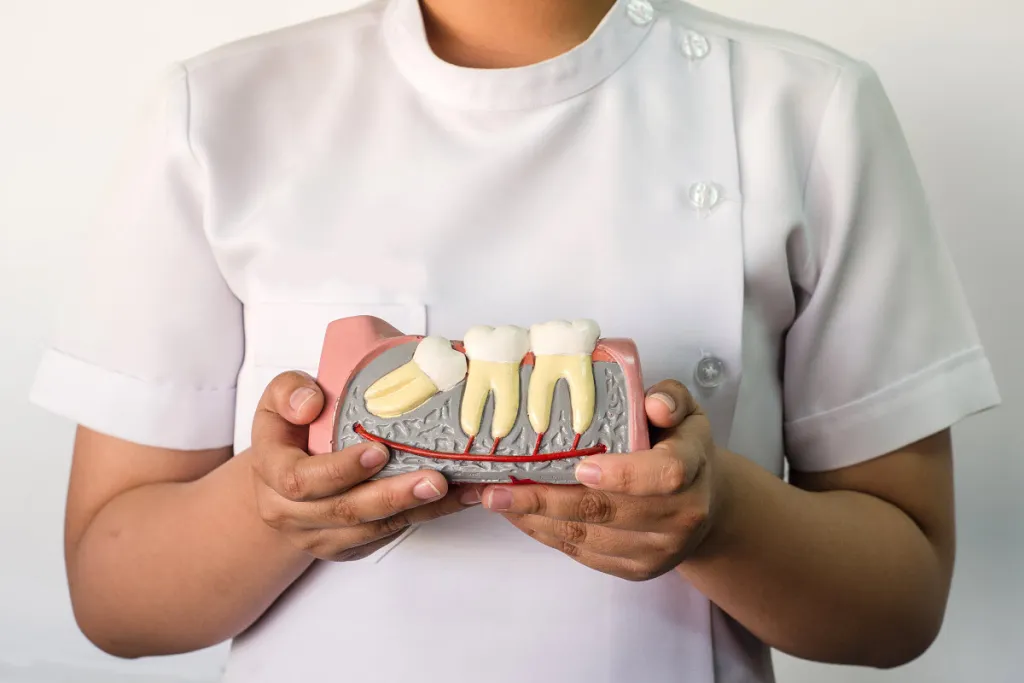
Wisdom teeth, commonly referred to as the third set of adult molars, typically make their appearance between the ages of 17 and 25. Positioned at the rear of the mouth, these molars often come in pairs, with two on the upper and two on the lower rows of teeth. However, when the development of wisdom teeth is hindered due to overcrowding at the back of the mouth, they can become impacted.
Impacted wisdom teeth are notorious for their potential to induce pain, damage to adjacent teeth, and various dental complications. Moreover, their positioning makes them challenging to clean, heightening the risk of gum disease, tooth decay, and infections. In some instances, though, restricted wisdom teeth may not present immediate or obvious issues.
The removal of wisdom teeth is typically recommended when they cause pain and dental complications. Some dental professionals may also advise the extraction of asymptomatic impacted wisdom teeth as a preventive measure against potential future problems.
Symptoms to Be Aware Of:
crowded wisdom teeth may not always exhibit noticeable problems, but they can manifest distinct symptoms, particularly as the condition progresses and affects neighboring teeth. These symptoms include:
- Throbbing or radiating pain in the impacted tooth or the temporomandibular joint (TMJ).
- Redness, tenderness, swelling, or bleeding of the gums.
- Swelling or discomfort in the jaw area.
- Headaches.
- Cysts, tumors, or infections.
- Persistent bad breath (halitosis) and an unpleasant taste in the mouth.
- Tooth decay.
- Damage to adjacent teeth.
What Leads to an Impacted Wisdom Tooth?
The impaction of wisdom teeth occurs when the jaw lacks sufficient space for them to erupt and develop normally. This can result in partial or full impaction. Partial impaction is characterized by the tooth emerging through the gum, exposing part of the crown while the rest remains below the gum line. Full impaction, on the other hand, occurs when the tooth fails to emerge and is entirely concealed beneath the gums.
Impacted wisdom teeth can manifest in different variations, each corresponding to the tooth’s positioning:
- Distal impaction: The wisdom tooth angles towards the back of the mouth during eruption.
- Mesial impaction: The wisdom tooth grows at an angle toward the second molar.
- Horizontal Impaction: The wisdom tooth is fully impacted and horizontally situated beneath the gum line.
- Vertical Impaction: The wisdom tooth is correctly aligned for eruption, growing straight upward, but remains trapped within the jawbone.
Impact on Overall Oral Health:
Impacted wisdom teeth can result in various oral health issues, with some being more severe than others:
- Damage to neighboring teeth, including crowding and potential orthodontic treatment needs.
- Gum disease risk, particularly in the case of partially erupted wisdom teeth, which are challenging to clean and may lead to pericoronitis.
- Formation of cysts, potentially causing damage to nerves, jawbone, and adjacent teeth. Rarely, noncancerous tumors can develop, necessitating the removal of bone and tissue.
- Increased susceptibility to tooth decay due to food particles and bacteria being trapped between partially impacted wisdom teeth and the gums, making them harder to clean.
Treatment for Impacted Wisdom Teeth:
In cases where impacted wisdom teeth cause pain, discomfort, or dental issues, extraction is typically recommended. Wisdom tooth extraction is performed under local or general anesthesia, depending on the complexity of the procedure. The oral surgeon makes an incision to extract the tooth, sometimes breaking it into smaller pieces for easier removal. The duration of the procedure depends on the tooth’s depth.
Post-extraction, you’ll receive instructions on managing pain, swelling, and wound care during the recovery period. While many individuals recover within a few days, it may take up to two weeks to return to regular activities.
In Conclusion:
The prospect of removing impacted wisdom teeth may seem daunting, but early intervention can prevent serious and permanent complications. If you experience pain or symptoms arising from the area behind your last molar, it’s advisable to schedule an appointment with your dentist without delay.



